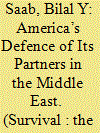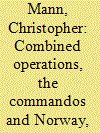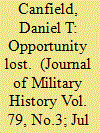| Srl | Item |
| 1 |
ID:
188452


|
|
|
|
|
| Summary/Abstract |
The main factors American presidents typically consider before committing military resources to protect a partner include perceived US national interests, US domestic politics, the nature of the attack itself, the aggressor’s military capabilities and the possibility of escalation. An additional factor is the ability and willingness of the partner to conduct joint and combined operations with the United States and possibly others. This is critically important in the Middle East. As Washington prioritises the Indo-Pacific and Europe, US military forces will draw down in the Middle East and be less able to intervene promptly. To maintain strong regional deterrence, security arrangements between the United States and its Arab partners should be reconfigured to ensure that they can confront regional threats, Iran’s in particular, without immediate American assistance. The will require American advice and assistance in creating sustainable and effective joint forces.
|
|
|
|
|
|
|
|
|
|
|
|
|
|
|
|
| 2 |
ID:
088679


|
|
|
| 3 |
ID:
140930


|
|
|
|
|
| Summary/Abstract |
This article examines the use of combined army-navy operations and the development of Union military strategy during the first year of the war. It argues that the army and the navy, despite differences in service culture, a paucity of joint doctrine, and the absence of a “formal” general staff system were, in fact, working together to design and implement an overall strategic concept during the crucial opening months of the conflict. Despite several early examples of impressive inter-service cooperation, however, the greater use of combined army-navy operations eventually succumbed to the confluence of personality, military paradigm, and strategic choice.
|
|
|
|
|
|
|
|
|
|
|
|
|
|
|
|